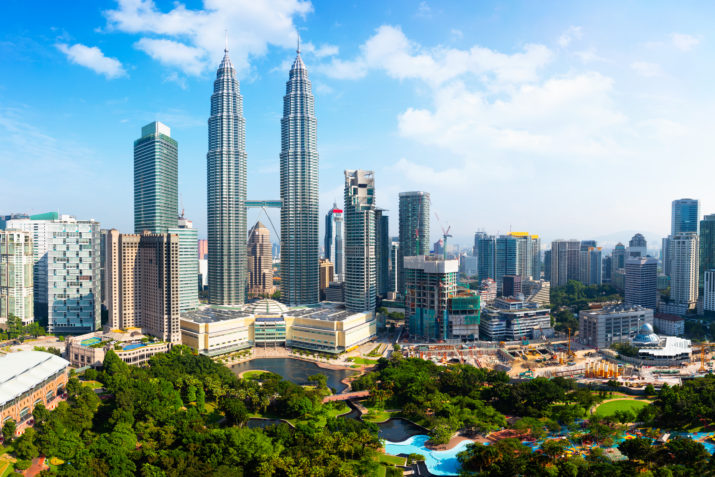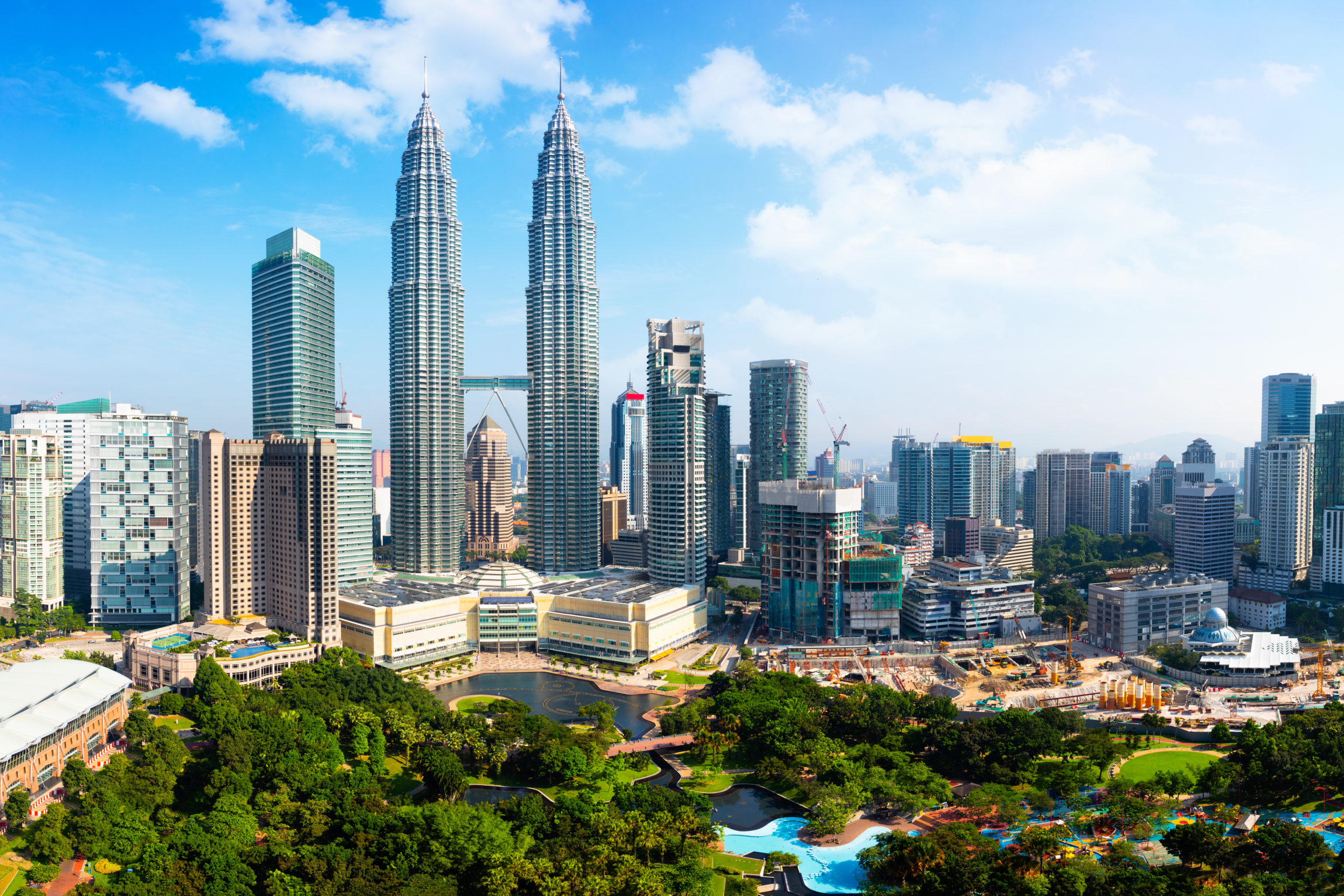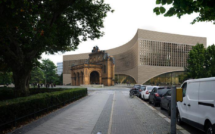

This is an introduction to our Campus Spotlight on Sarah Lawrence College, and part of our special feature, Displacement, Memory, and Design.
In 2019, Sarah Lawrence faculty Parthiban Muniandy led a group of undergraduate students from Vassar, Sarah Lawrence, Bennington, and Bard colleges on an intensive field-research study abroad trip to Malaysia. The summer program was part of Sarah Lawrence’s Signature project designed for the Consortium on Forced Migration, Displacement and Education, and had been planned for an initial four-year period between 2019-2022. The Malaysia summer program was focused on providing students the opportunity to work with and learn directly from community members, activists,and advocates for refugees and asylum-seekers living in Malaysia, including the Rohingya communities who live in settlements in Kuala Lumpur, Seberang Prai, and Penang. The program has only been run once in the summer of 2019 and has been delayed indefinitely due to the circumstances of COVID-19 and restrictions on travel to Malaysia, where the Delta variant has caused an unprecedented surge in cases over the past year. It is our hope that along with greater vaccination rates and the gradual lifting of restrictions in Malaysia, that the Malaysia program will resume in the coming academic year, and a new group of students from the partner colleges will be able to travel and engage in the field-research trip.
In partnership with Dr. Valeria Bonatti from University of Illinois, students in the program engaged in an ethnographic study of ecology and environmental displacement through tours of Kuala Lumpur and Selayang. The sites referenced in this piece include areas that the study abroad group visited in 2019. The ethnographic tours were made possible with the help and support of local Malaysian NGOs and activists, including Adriana Manan, S.C. Shekar, and Jules Wong.
Building the hyper-modern city
Slam, slam, dum, dum dum,
Slam, slam, dum, dum, dum…
It’s almost six in the morning and I am standing on the top floor of a newly mint service apartment building, not far from Bukit Bintang. Several feet below me, the city is waking up, with little traffic and some food stalls already open for breakfast, yet I can hardly hear a sound from the street below. It is the sounds of construction work, in the distance, that dominate the soundscape, as workers I cannot see but I know must be there mold concrete and iron into a new tower, some ten blocks away from me. I do not know who is working in that tower specifically, but I do know that over the past ten years, the majority of construction work in KL has been carried out by labor migrants—Bangladeshi, Nepali, and Indonesian men, just to name a few. I know they are there, but only because I can hear them, and I can hear them only because it’s early in the morning. In a few hours, they will still be there working, invisible, and unheard. (VB 2019)
According to The Kathmandu Post (Mandal, 2020), 2,672 Nepali workers have died while working in Malaysia, between 2006 and 2015, and that figure is believed to be an underestimate. And over the past five years alone, the skyline of KL has changed quite drastically, from an overall contained city, dominated by the Petronas towers, to a large sprawl of real estate speculation (Lee, 2014), funneled by growing desires for westernized life, international capital, and disenfranchised labor migrants. For Nepali migrants, construction labor is one of the only formal labor sectors that are available in Malaysia, under the state’s migrant labor laws. Malaysia, for the last three decades, has been a prime adopter of managed migration regimes based on bilateral trade agreements, Memorandums of Understandings (MOUs) with neighboring sending countries, and neoliberal restructuring of labor sectors (based on nationality and gender) that has had significant impact and influence over transnational migration and mobility, not just regionally but globally. Today, the global shortage in semiconductors and other key commodities can be directly linked to the impact of the COVID-19 surge in Malaysia, which has, in a way, helped reveal some of these transnational dependencies on migrant labor both in manufacturing as well as logistics.
The recent environmental history of Malaysia has come to embody many of the contradictions of neoliberal approaches to nature, and environmental preservation. On the one hand, the frenzy of mass consumption, of which real estate speculation is perhaps the most visible representation, has come to dominate much of contemporary society. On the other hand, the country has also been one of the world’s largest producers of palm oil crop, and an important producer of biodiesel, in the past two decades, with support from the government, and semi-state-owned conglomerate Petronas (Our World in Data, 2021). As global mass consumption rises, Malaysia is also becoming the site of diverse, and at times contradictory environmental politics ranging from individual families and NGO to industrial waste trade and, unfortunately, as a node for the trafficking of e-waste (Legambiente, 2011) and plastic.
Labor migrants are part and parcel of all such efforts and enterprises, through their paid labor, as well as unpaid efforts to recover construction waste and other waste materials, which in part goes towards ameliorating the makeshift housing available to them on construction sites, and in part, are forced to do, to try and contain the contamination and smell of toxic material abandoned or dumped in situ. In this essay, we will focus on the roles, risks and experiences that labor migrants and displaced persons play on a largely informal basis in the treatment of different waste materials, including plastics, metal, food, and construction materials.
“Migrants” as a category spans a very wide spectrum of people and communities in parts of the global South where formal recognition of different status may not be available or limited. The country of Malaysia, for example, is host to migrant and displaced communities (including refugees and asylum seekers) that are both documented and undocumented, and often “invisible” in many ways (as revealed in Muniandy’s 2021 book, Ghost Lives of the Pendatang). Migrant groups include formally employed laborers from neighbouring Indonesia, Thailand, Philippines and Myanmar, as well as further away from Bangladesh, Nepal, India and Sri Lanka. Malaysia’s non-recognition of refugees and asylum seekers has also meant that the substantial numbers of Rohingya, Afghan and Syrian refugees who have been displaced and found their way to the country live primarily as undocumented immigrants—or PATI (Pendatang Tanpa Izin). And to these large cohorts of displaced persons, here we also add Malaysia’s Orang Asli and other indigenous communities who are being displaced from their historic homelands and ways of life, and pushed into manual labor for the sake of an expanding consumer economy.
With over 25 percent of the adult working force in Malaysia estimated to be foreign-born, Malaysia’s rapid development since the 1980s as one of the so-called “Asian Tigers” has long been heavily reliant on migrant labor, both documented and undocumented. Hyper-development in newly developing Asian countries such Singapore and Malaysia share this reliance on migrant labor, not just in a formal sense but also in terms of a large and essential informal sector, where many undocumented immigrants, refugees and asylum seekers are able to find work and opportunities to make a living without formal recognition or reliance upon public support. This is a key reason as to why over 150,000 Rohingya refugees have been able to find a precarious yet relatively peaceful communal existence in urban centers like Kuala Lumpur and Penang. Rohingya refugees find their way to Malaysia through various land and sea routes, and are primarily trafficked in by human smugglers working across transnational borders, from Myanmar, Thailand to Malaysia. Many refugees often find themselves pushed onto fishing boats and trawlers on the Straits of Malacca, and only the more fortunate ones find safe harbor in Malaysia, while more tragic reports indicate people who are left to drown or abandoned at sea. Those who do make it safely in Malaysia must still contend with statelessness and the lack of recognition of their refugee status. Undocumented victims of trafficking in Southeast Asia make up a significant part of the “Sea Slaves” that drive global fishing industry (Urbina, 2019). Ongoing analysis of the consequences of the Covid-19 pandemic are showing that the risk of trafficking in the region is increasing (Lin, 2020).
The informal sector in Malaysia is diverse, robust and encompasses a myriad of arrangements, networks, practices and relationships that allow different migrant communities to find work and make a living, whether it is by becoming day laborers working for construction and public works, in Malaysia’s expansive tourism and agricultural sector, or in the highly risky but very profitable sex-work industry (Chin 2013). Here, we seek to highlight an increasingly important yet little known dimension of migrant and refugee labor that has become prominent in countries such as Malaysia – labor tied to environmentalism and contamination.
Many of the wealthier commercial and historical parts of KL and Penang are generally kept in mint conditions. Shopping malls such as Pavillion and KLCC, as well as the historical district surrounding Central Market are carefully set up to entertain international tourists with ideas of Malaysia’s history and crafts, as well as modernity. Increasingly, this space is served and inhabited by growing numbers of international tourists and served by foreign labor migrants. Among the various services they provide, careful waste management and cleaning services are key.
Migrant men and women of different ethnicities sweep the sidewalks and pathways in different parks of KL. Whenever they come across a metal can, they set it aside. They all wear the same uniform, from a local trash collection and sanitation company, and many of them wear tanaka on their faces, suggesting that they may be Rohingya or another Myanmari group. A similarly diverse group of workers in uniforms wait on the garbage bins inside of Central Market and in the shopping stalls right outside. They appear, discreetly, every now and then to empty garbage disposal bins once they are full, and to separate metal container—soda cans for the most part—in a separate bag for recycling. – VB, 2019
It is clear from these observations that the labor force tasked with keeping KL clean and sanitary is diverse, and that the sorting of waste materials already begins in the city center, with metals being particularly on demand. In areas as visible as Pavillion, Central Market, or Bukit Bintang, the only material that is set aside in broad daylight is metal. However, the waste stream, meaning the life of materials since the moment they are discarded, does not end in the city center. Rather, as is increasingly common on a global scale, materials such as paper and plastic, and toxic residues are separated further along the waste stream, in areas that are more visible, and by populations that are also marginalized (Bonatti and Gille, 2019).
Refugees in the Market
The Selayang Wholesale Market is in the peri-urban margins of Kuala Lumpur. It is the city’s most important food and produce exchange and transport hub. It is also home to Malaysia’s largest refugee community, predominantly made up of Rohingya and other Myanmari refugees. Selayang itself is an older township that used to be home to rural and working-class Malay communities, many of whom have left to wealthier areas. Right outside the market, a new luxury compound is recently built on an artificial lake covering the entrance to an old mine. Townships like the one where the market is located have largely been abandoned, or left behind, and it is the refugee communities that have given new life and significance to the place. Life at the market is precarious, difficult, and often fraught as refugees who depend upon opportunities to work as informal laborers in the market itself also have to contend with frequent harassment from authorities, labor abuses, poor working conditions, workplace accidents, and disease. At the same time, these refugee communities have also been able to establish microeconomies, through largely informal practices and arrangements that have contributed significantly to stabilizing their presence as a community.
Along with the help of local advocates and activists, refugees in Selayang have been able to start small businesses selling food, crafts, and services while also creating spaces such as informal schools, madrasahs, and gathering spaces. The informality extends to arrangements where refugees can scavenge, collect and secure goods such as food, medicines, and school supplies through the NGOs, the market, and other migrant communities.
In sites such as the Selayang Wholesale Market and its surrounding vicinities, refugees and migrants’ work has them engaging with the sale and packaging of food, as well as with the cleaning up and sanitation of food waste, and the recycling of containers such as cardboard boxes and wooden crates. As in the construction areas, part of these materials are reused in situ, in homes, shops, and stalls, while food waste is hauled into large disposal bins, and surfaces of the market are sanitized regularly, at least every two hours. Even so, the smell in the market, and in the surrounding compound is pungent, as much of the makeshift housing that surrounds the market lacks proper sanitation. The refugees and migrants in Selayang play a key role in supplying the rest of KL with fresh produce—a labor that requires them to deal with the resulting waste and refuse generated in the wholesale market and the vicinities. If more privileged consumers can thus enjoy materials as commodities, meaning, in their “cleanest” and most appealing forms, labor migrants and refugees handle the whole lifespan of such objects, including the least desirable waste stage.
Displacement and Malaysia’s Indigenous communities
Since 2017, Malaysia has been the world’s largest importer of plastic waste (Chen, Nat and Lecner, 2021), and one of the world’s main exporters of resins used for global plastic production. Malaysia also has one of the highest rates of plastic waste mismanagement globally, with 85 going to landfills. Plastic waste is transported, dumped and occasionally, separated into Malaysia’s rural inland, into the communities, homes, and natural environments of the few remaining indigenous populations, who then have little choice but to work in such dumpsites, recovering plastic bottles and materials from a very young age. Private waste collection companies and other businesses are constantly pushing indigenous groups away from their historical homes and ways of life, dispossessing them and displacing them of the forest and natural waterways they depend upon for livelihood, and into waste work, for lack of alternatives. Similar instances of environmental racism and displacement are taking place globally, in February 2021 the case of Malaysia’s Orang Asli made the headlines of local newspapers.
Bapak Motot, a man living in one such Asli community shared with journalist Ruth Wong and photographer S.C. Shekar, “in a good month, he can earn up to RM 700 to feed his family” from selling recyclables to a private contractor from the city. Unfortunately, Wong continues, “such waste also contains syringes and bio-hazards.”
In the parts of Malaysia that are the least visible to the country’s expanding urban middle classes and tourists that the sorting and sale of waste materials takes place, away from the public eye. It is through these different steps of the waste stream that the dispossession of indigenous communities intersects with the lives of labor migrants in construction sites in the center of KL, and of Rohingya refugees in Selayang.
In 2020, the outbreak of Covid-19 put a halt to many of the informal economies that gave a living to displaced persons in Malaysia, while at the same time giving way to new forms of mass consumerism, and waste. While studies on waste and covid-19 are still underway, Benson and co-authors (202o) estimated that in Malaysia, where mask mandates are widely accepted, 20,196,383 masks are discarded daily, and this does not take into consideration the tons of PPE waste that are imported and trafficked into the country (Benson, Bassey, and Palanisami, 2020). Refugees and undocumented communities were particularly badly affected as they suddenly fell through the crosshairs of immigration enforcement, who weaponized public health mandates to persecute them (Human Rights watch, 2021). As of June 2021, prominent indigenous figures are actively advocating for the government to deliver vaccines promptly to their communities (Malay Mail, 2021), conscious of the additional risks that they face because of social factors, such as malnutrition and poverty (Latiff and Ananthalakshmi, 2020). In the meantime, while air pollution has decreased during lockdowns, global volumes of PPE waste continue to grow, and unless there are drastic changes from previous waste regimes, it will continue to be the most disenfranchised and vulnerable groups in society that deal with its toxicity, as victims of environmental racism, and as laborers tasked with cleaning up after more privileged groups.
The relationship between global and local production, waste management, and recycling are deeply tied into the transnational displacement of communities both between and within countries, such as the cases of Malaysia’s refugees, migrant, and indigenous communities. Here, we are able to show, in these examples, the profound ways in which even seemingly remote and unrelated communities are linked together through these networks of neoliberal production (and waste), that are global. The impacts of the pandemic have further exacerbated many of the already precarious and vulnerable conditions under which Rohingya refugees, migrants and the Asli communities live under, and the imminent threat of further displacement and exploitation due to increased precarity is one that should be of international concern.
Parthiban Muniandy is faculty in Sociology at Sarah Lawrence College. He has served as faculty director at SLC for the Consortium on Forced Migration, Displacement and Education from 2018-2021. Dr. Muniandy’s research and teaching focus on displacement, transnational migration and development in the Southeast Asian context, and he has recently published Ghost Lives of the Pendatang: Informality and Cosmopolitan Contaminations in Urban Malaysia.
Valeria Bonatti is a Lecturer of Global Studies at the University of Illinois Urbana-Champaign. Her teaching and research focus on environmental justice and health advocacy among migrants, refugees, and women. Some of Dr. Bonatti’s recent work appeared in Europe Now, in Migration Studies, and in International Labor and Working-Class History
References
Benson, Nsikak U., David E. Bassey, and Thavamani Palanisami. “COVID pollution: impact of COVID-19 pandemic on global plastic waste footprint.” Heliyon 7, no. 2 (2021): e06343.
Bonatti, Valeria, and Zsuzsa Gille. “Changing registers of visibility: immigrant labor and waste work in Naples, Italy.” International Labor and Working-Class History 95 (2019): 114-129.
Chin, Christine BN. Cosmopolitan sex workers: women and migration in a global city. Oxford University Press, 2013.
Human Rights Watch “Malaysia: Raids on migrants hinder vaccine access” June 30 2021. Retrived July 14 2021 from https://www.hrw.org/news/2021/06/30/malaysia-raids-migrants-hinder-vaccine-access
Rosanna Latiff and A. Ananthalakshmi, 2020 “Malaysia’s indigenous people flee into the forest to escape Coronavirus” Reuters, April 2nd, retrieved July 14 from https://www.reuters.com/article/us-health-coronavirus-malaysia-indigenou/malaysias-indigenous-people-flee-into-forests-to-escape-coronavirus-idUSKBN21L0EL
Lee, Julian C. H “Citizenship and the City: Visions and revisions of Malaysia” in Guan, Y. S. (Ed.). (2014). The Other Kuala Lumpur: Living in the Shadows of a Globalising Southeast Asian City. Routledge.
Legambiente, 2011 Ecomafia Globale: “Radiografia dei Traffici Illectiti dei Rifiuti: i numeri, le rotte, i Paesi coinvolti e le proposte”. Edited by Legambiente Polieco, Roma. Retrieved July 14, 2021 from https://www.legambiente.it/sites/default/files/docs/dossier_ecomafia_globale_traffici_0.pdf
Lin, Leo. “Southeast Asia Human Trafficking Risks Are Increasing in the Time of Covid” The Atlas Institute for Internaitonal Affairs July 29, 2020 Retrieved July 14, 2021 from https://www.internationalaffairshouse.org/southeast-asia-human-trafficking-risks-are-increasing-in-the-time-of-covid-19/
Malay Mail, 2021 “In perak, Orang Asli leaders receive covid jab to inspire community to do so” July 11, retrieved July 14 from https://www.malaymail.com/news/malaysia/2021/07/11/in-perak-orang-asli-leaders-receive-covid-jab-to-inspire-community-to-do-so/1988967
Mandan, Chandar Kumal 2020. “Hundreds of young, healthy Nepali men die sudden deaths in foreign lands. No one knows what;s killing them” The Kathmandu Post February 29, retrieved July 14, 2021 from https://kathmandupost.com/national/2020/02/29/hundreds-of-young-healthy-nepalis-die-sudden-deaths-in-foreign-lands-no-one-knows-what-s-killing-them
Muniandy, Parthiban. Ghost Lives of the Pendatang: Informality and Cosmopolitan Contaminations in Urban Malaysia. Palgrave MacMillian, Singapore, 2021.
Hannah Ritchie and Max Roser (2021) – “Forests and Deforestation”. Published online at OurWorldInData.org. Retrieved from: ‘https://ourworldindata.org/forests-and-deforestation’
Urbina, Ian. “Sea Slaves”: The Human Misery That Feeds Pets and Livestock.” The New York Times 27 (2015). Accessed July 14, 2021 from https://www.nytimes.com/2015/07/27/world/outlaw-ocean-thailand-fishing-sea-slaves-pets.html Wong, Ruth, 2020 “Forgotten, Orang Asli in a Pahang Town live off a landfill of toxic garbage” Malay Mail Feb. 14 Retrieved July 14, 2021 from https://www.malaymail.com/news/malaysia/2020/02/14/forgotten-orang-asli-in-a-pahang-town-live-off-a-landfill-of-toxic-garbage/1837378
Photo: Kuala Lumpur city skyline, Kuala Lumpur Malaysia | Shutterstock




